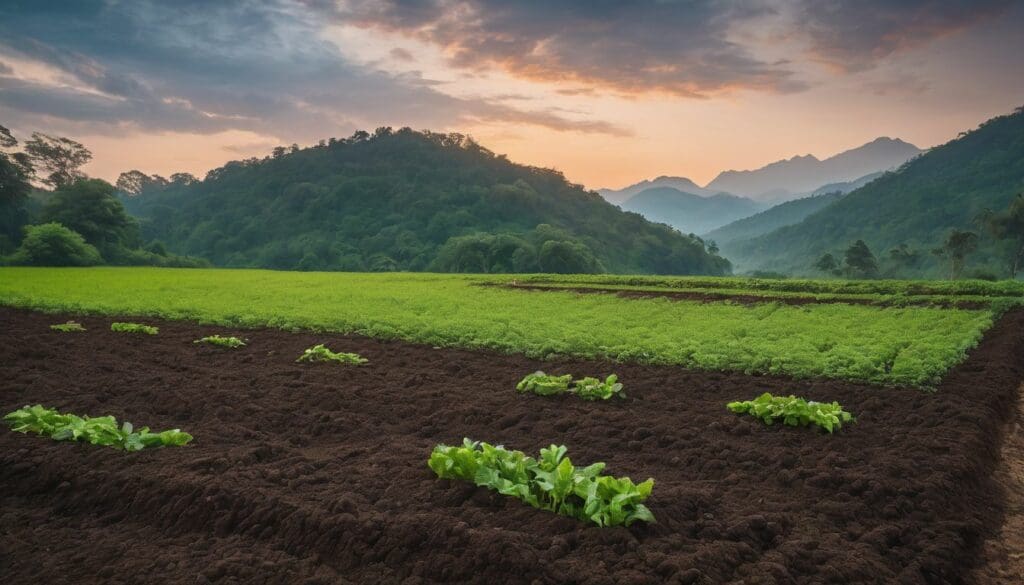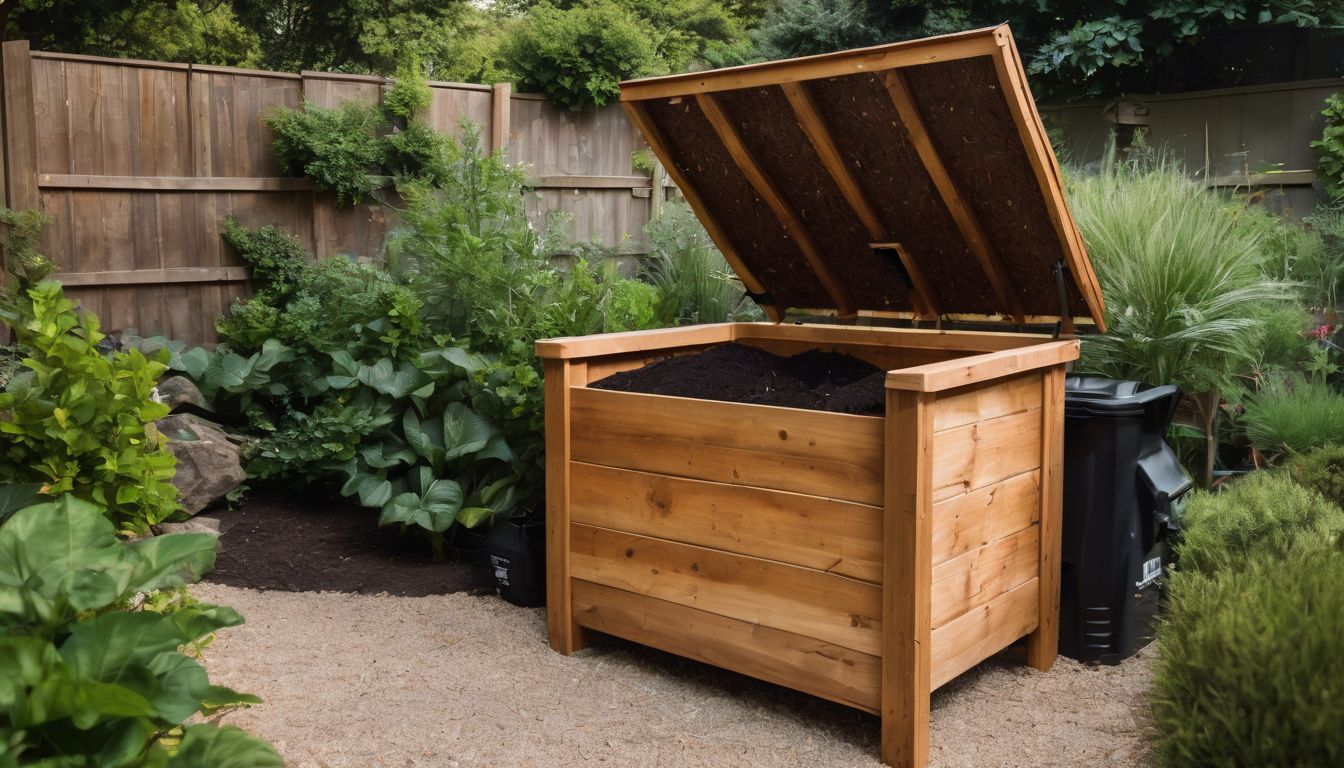Battling soil erosion can feel like a relentless challenge for gardeners and landscapers. Compost, rich in organic matter, stands as a key ally against this environmental issue. This post will guide you through compost‘s role in fortifying soil structure, thus curbing erosion effectively.
Dive into nature’s own strategy to keep the earth firmly underfoot.
Key Takeaways
- Compost is a powerful tool against soil erosion, improving soil structure by binding particles and increasing water infiltration to reduce runoff.
- Applying compost through methods like blankets and berms provides a natural barrier against erosion, enhancing soil fertility without the need for chemicals.
- To maximise the effectiveness of compost in preventing erosion, it’s important to use mature compost at proper application rates and with compatible methods alongside other controls.
- Obstacles such as coarse material or trash in compost must be screened out to ensure optimal performance in stabilising soils and protecting landscapes.
- Integrating compost into erosion control strategies supports sustainable land management and environmental conservation efforts on a long-term basis.
Compost: What is it and How Does it Work for Erosion Control?
Compost is a rich soil-like substance resulting from the controlled decomposition of organic materials, such as leaves, grass clippings, and kitchen scraps. It boasts a high humus content that significantly improves soil structure by binding together soil particles.
This natural process creates an environment beneficial for plant growth and offers excellent moisture holding capacity which can be key in erosion control.
In the fight against erosion, utilising compost has become an effective weapon due to its ability to absorb water and increase infiltration while reducing stormwater runoff. This slows down the speed at which water moves across the surface, preventing raindrop splash erosion – one of the primary causes of soil degradation.
Moreover, applying compost to disturbed lands aids revegetation efforts by providing new plants with vital nutrients needed for establishment and growth. These aspects make compost not only a powerful tool for maintaining healthy soils but also crucial in safeguarding landscapes from erosive forces.
Benefits of Using Compost for Erosion Control
Compost improves soil stabilisation, increases infiltration, and reduces surface water flow. These benefits make it an effective and sustainable method for controlling erosion.
Soil stabilisation
Soil stabilisation is one of the key benefits of using compost for erosion control. The addition of compost helps to bind soil particles together, reducing the risk of erosion due to wind and water.
Compost also aids in improving soil structure, promoting better drainage, and enhancing the overall stability of the land. By incorporating compost into the soil, it becomes less susceptible to erosion and maintains its integrity even during heavy rainfall or windy conditions.
Incorporating compost into erosion control practices can significantly contribute to sustainable agriculture and green infrastructure. Utilising compost can play a vital role in maintaining healthy soil while preventing erosion, ensuring long-term soil health and productivity.
Increased infiltration
Compost aids in increased infiltration, allowing water to penetrate the soil rather than running off, which reduces erosion. The organic matter in compost improves soil structure, increasing pore space and enhancing the soil’s ability to absorb and retain moisture.
This means that water can move more easily through the ground, reducing runoff and helping to prevent sediment from being washed away.
Moreover, improved infiltration provided by compost helps replenish groundwater sources and provides essential moisture for plants’ roots. By using compost as an erosion control measure, individuals can contribute to sustainable land management and protect natural resources for future generations.
Reduced surface water flow
Compost reduces surface water flow by increasing the soil’s capacity to absorb and retain moisture. This helps prevent erosion by slowing down the movement of water over the ground, reducing runoff and minimising soil loss.
The organic matter in compost improves soil structure, promoting better drainage and preventing excessive water from flowing across the surface.
In addition, incorporating compost into the soil decreases surface sealing, which typically occurs due to heavy rain or irrigation. As a result, reduced sealing encourages infiltration instead of allowing water to run off quickly.
Best Practices and Applications for Compost in Erosion Control
Compost blankets and filter berms are effective applications for erosion control, with recommended specifications for optimal results. Read on to learn how compost can be best utilised to prevent erosion.
Compost blankets
Compost blankets consist of a layer of compost and organic materials applied directly to the soil surface. They help prevent erosion by improving soil structure, promoting water infiltration, and reducing runoff.
Compost blankets also provide a protective barrier against wind and rain, allowing seeds to germinate and establish vegetation while minimising soil loss.
By enhancing soil fertility and stability, compost blankets offer a natural solution for erosion control without the need for synthetic additives or chemicals. Their biodegradable nature makes them an environmentally friendly choice for conserving soil and preventing sediment from polluting waterways.
Compost filter berms
Transitioning from compost blankets, another effective method for erosion control is the use of compost filter berms. Compost filter berms are strategically placed in areas prone to erosion to slow and trap sediment runoff while allowing water to pass through.
These berms consist of compost enclosed in biodegradable netting or other permeable materials, which helps stabilise the soil while filtering out pollutants and retaining moisture.
Compost filter berms work by reducing surface water flow velocity and promoting infiltration, thus preventing soil erosion and sedimentation. This natural method not only provides effective erosion control but also enriches the soil with beneficial organic matter, promoting overall soil health and stability.
Recommended specifications
- The compost should have a particle size between ¼ inch and 1 inch for optimal performance.
- Use mature, well – decomposed compost with a C:N ratio below 20:1 to ensure that it will not compete with soil organisms for nitrogen.
- Ensure that the compost used has been tested for pH levels and is within the range of 6 to 8, promoting healthy soil conditions.
- When applying compost as a soil amendment, maintain a thickness of at least 3 inches to achieve the desired effect on erosion control.
- It is important to source organic compost materials without any trash content, ensuring that only high-quality natural fertilisers are used for effective erosion control methods.
- Prioritise using certified compost products that meet established standards for erosion prevention and soil conservation.
- Compost should be applied at recommended rates and integrated properly with other erosion control measures to maximise its benefits in reducing sediment flow and promoting soil stability.
Common Obstacles and Limitations of Using Compost for Erosion Control
– Coarse compost and high trash content may hinder the effectiveness of erosion control. Proper application rates and methods are crucial to ensure optimal performance. Compost compatibility with other erosion control measures should also be carefully considered for successful implementation.
Coarse compost and trash content
High levels of coarse compost and rubbish content present challenges in erosion control. These materials can hinder the effectiveness of erosion control practices, impeding sediment control and pH improvement.
They may also affect the compost’s ability to stabilise soil and reduce surface water flow. To address this issue, it is essential to carefully screen compost materials for excessive coarseness and unwanted debris before application.
Moreover, incorporating proper waste management practices at composting facilities can significantly minimise the presence of coarse material and rubbish in the final product, ensuring that the compost meets recommended specifications for erosion control applications.
Proper application rates and methods
To ensure effective erosion control using compost, it is essential to adhere to proper application rates and methods. This will optimise the benefits of compost in preventing soil erosion and improving soil health.
- Application rates should be determined based on soil type, slope, and rainfall intensity to ensure adequate coverage and performance.
- Methods such as compost blankets or filter berms should be applied in accordance with recommended specifications to achieve the desired erosion control outcomes.
- Monitoring and maintenance are crucial to ensure that the compost remains effective over time, requiring periodic assessment and supplementation when necessary.
Compost compatibility with other erosion control measures
When considering erosion control, it’s essential to understand how compost interacts with other measures. Compost can complement traditional erosion control methods like silt fences and straw barriers, providing an added layer of protection against soil loss.
This compatibility enhances the overall effectiveness of erosion control efforts by improving soil structure and reducing water runoff.
Additionally, combining compost with bioengineering techniques such as live stakes or wattles can create a synergistic effect that maximises erosion prevention. The interplay between compost and other measures underscores the importance of integrating sustainable practices for long-term environmental preservation.
Conclusion: The Importance of Utilising Compost for Erosion Control.
Utilising compost in erosion control is crucial for stabilising soil, increasing infiltration, and reducing surface water flow. Implementing best practices like compost blankets and filter berms can effectively mitigate erosion.
Despite obstacles such as coarse compost and proper application methods, the benefits of using compost far outweigh the limitations. Compost plays a vital role in sustainable erosion control efforts and supports environmental conservation initiatives.
FAQs
1. What role does compost play in controlling erosion?
Compost acts as a natural barrier for soil, helping to hold it together and reducing the risk of erosion by water or wind.
2. How is compost applied for erosion control?
Compost is spread over vulnerable areas where soil erosion might occur, creating a protective layer that encourages plant growth and stabilises the ground.
3. Can using compost improve soil health besides controlling erosion?
Absolutely! Compost enriches the soil with nutrients, improving its structure and overall fertility while aiding in moisture retention.
4. Is compost environmentally friendly for managing erosion?
Yes, employing compost as an eco-friendly solution promotes sustainable land management and helps protect against harmful effects of soil erosion on landscapes.





